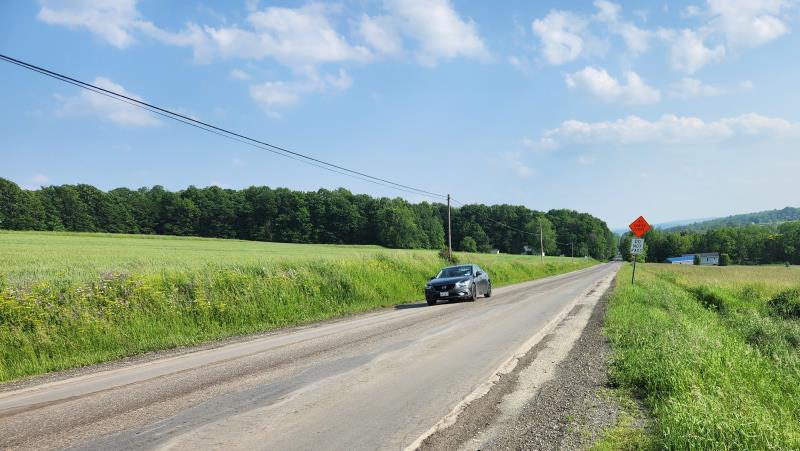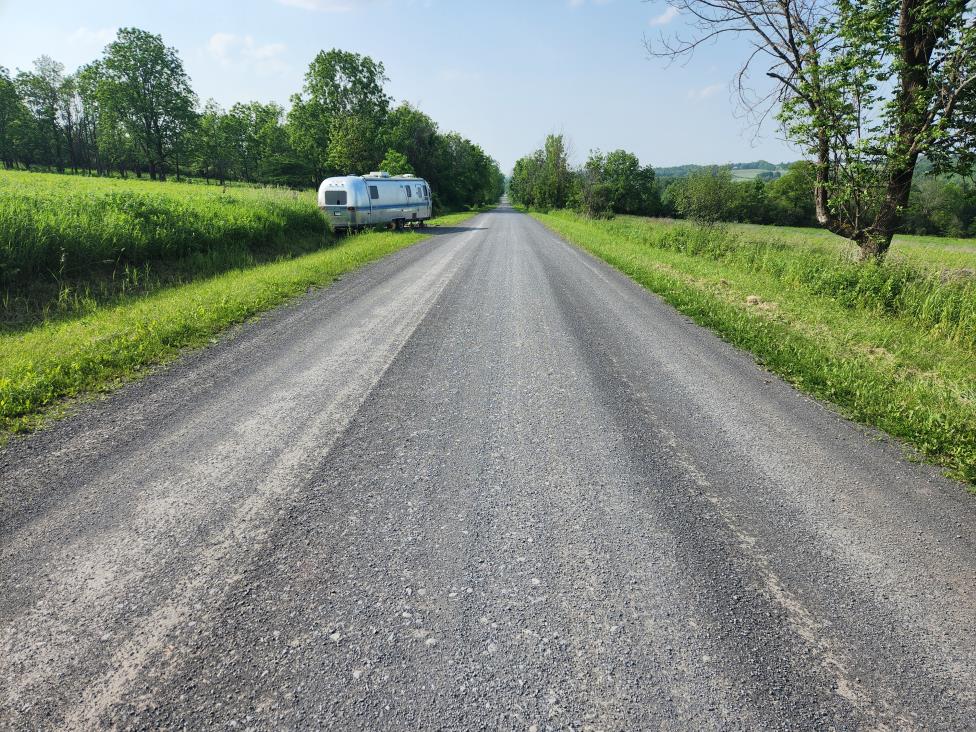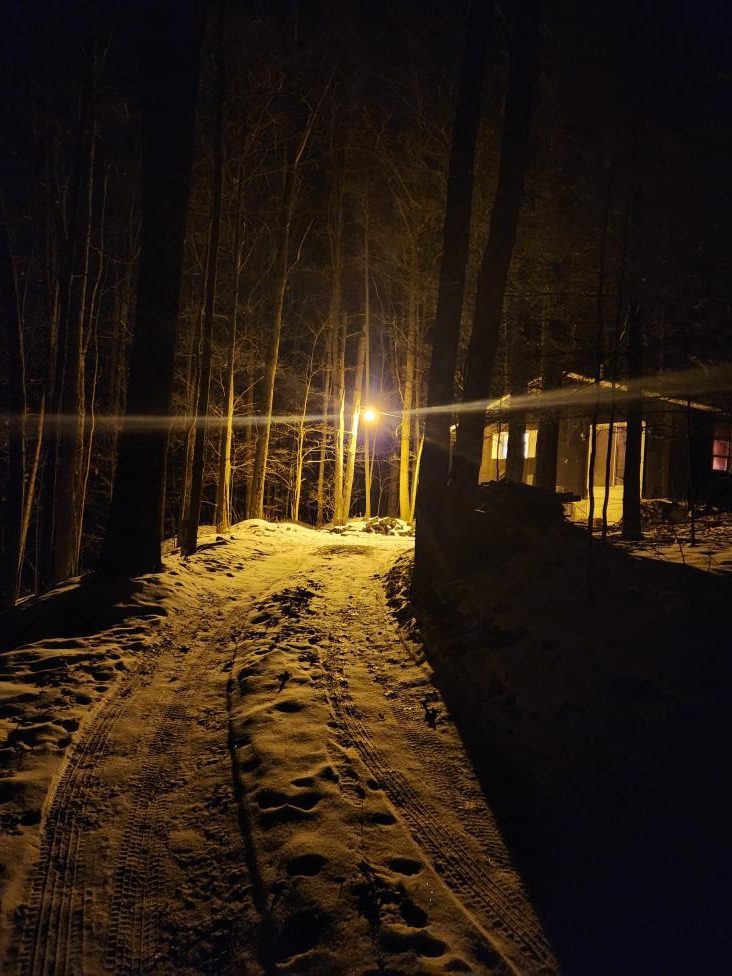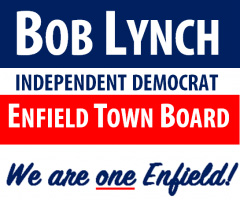Town Board also moves Subdivision Regulations off the dime
by Robert Lynch; June 13, 2025
Question: What’s the quickest route to Newfield or Elmira from Trumansburg—or for that matter, even from Waterloo? It’s not through traffic-clogged Ithaca. Instead, think Halseyville Road.

Most locals have known that time-saving secret for decades. And in a way, Halseyville Road knows it too. The all-so-convenient bypass has suffered the wear and tear of traffic. This year, the Tompkins County Highway Department will patch the route’s imperfections and give much of Halseyville Road, County Route 170, a new coat of asphalt. That’s good news.
But what’s not so good news is that better pavement brings higher speeds. Halseyville Road may masquerade as a state highway, but it’s still a country road. There are hills, blind spots, and plentiful cross-traffic. Moreover, the road serves as a favorite nighttime crosswalk for all too many deer.
Now, the Enfield Town Board has taken notice.
Guided, quite frankly, by an erroneous quirk on Google maps, the Town Board June 11th requested the New York State Department of Transportation conduct a traffic study of Halseyville Road to determine whether its speed limit should be cut from 55 Miles per Hour to 45 or lower.
“I’ve seen children crossing the road to school buses, and hoping to God that (they don’t get hit),” Councilperson Cassandra Hinkle said of Halseyville Road’s dangers Wednesday.
In a second Resolution, the Town Board asked for a similar traffic study on the little-traveled Tucker Road, the gravel-surfaced Town crossway that bisects the Breezy Meadows subdivision, likely soon to see new homes built.
As for Halseyville Road, “The posted speed limit is 55, but if you’re looking at your little phone or at your Google maps, it says 45, so we have some residents that want some clarification there,” Town Supervisor Stephanie Redmond said in bringing the speed limit reduction to the Town Board’s attention.
Enfield Planning Board Chair Dan Walker offered an explanation Wednesday of the computer-versus-real world anomaly. Put simply, it’s because Artificial Intelligence is dumb.
Think about it: Route 96 at Halseyville Road’s north end is reduced to 45 MPH. Enfield Main Road, NY Route 327, to which Halseyville becomes at its southern terminus, is also 45. There’s no speed limit sign anywhere in-between. So AI assumes Halseyville Road holds the speed restriction as well.
The Town of Enfield lacks authority to set speed limits on its own. Protocol dictates the Town first go to the Tompkins County Highway Department; and then, if approved locally, on to New York State.
Albany’s resistance has frustrated Enfield in the past. Following a fatal car-pedestrian accident in 2018, the Town Board asked the Department of Transportation (NYSDOT) for a lowered speed on Hayts Road at a blind hill near the Van Dorn Road intersection. New York rejected the request.
“NYSDOT professionals determined that lowering the speed limit would not be appropriate at this time,” Scott Bates, Regional Traffic Engineer for the Department of Transportation, wrote the Town in December 2022.
“Setting the speed limit at the prevailing free-flow speed (55 MPH) decreases conflicts, minimizes crashes, and makes it easier for vehicles and pedestrians to judge the speed of approaching vehicles,” Bates continued. He never mentioned the limited sight distance that likely caused the pedestrian’s death.
“They were counter-intuitive,” this writer, Councilperson Robert Lynch, said Wednesday of the Hayts Road decision. “It said it’s safer when people go faster, if you can believe what they said.”
Planning Board Chair Walker explained DOT’s logic differently. “They do speed monitoring. If the prevailing speed is over 50-55, they’re not going to reduce it down. People feel safe traveling at that speed,” Walker stated.
Dan Walker lives on Halseyville Road. He knows its propensity for deer hits. When it comes to the speed study, the planner quipped, “Make sure they do it during deer activity, because that’s what controls the speed.”
“I have never been too encouraged by the New York State Department of Transportation’s response to us,” Councilperson Lynch remarked, “but certainly it’s worth pursuing. I hope they grant it. It would be good because the road deserves to have a slower speed limit.”
Seeking a lowered speed limit on Tucker Road involves more of a leap of faith. Tucker Road may have some increased traffic now that the adjoining Breezy Meadows residential lots have been sold and buyers prepare to build. But travel’s still light, and the road’s only gravel-surfaced.

And when Enfield attempted in 2023 to cut speeds for the arguably better-surfaced Van Ostrand Road, also gravel, located on the Enfield-Newfield Town Line, NYDOT cited standing policy for its rejection.
“NYSDOT follows a practice of not posting speed limits on unpaved roadways,” Regional Engineer Bates wrote the Town that November. “Studies have shown that lowered posted speed limits on gravel roads have negligible impact on improving speeds and operations,” Bates wrote.
“It’s a dirt road, so they’re not going to do anything about it,” Supervisor Redmond lamented about Tucker Road after being reminded of the state policy. “But let’s submit it and see what they say.”
When the Breezy Meadows subdivision underwent Town Planning Board review in 2023, Enfield Highway Superintendent Barry “Buddy” Rollins determined that Tucker Road stood in adequate shape. He dismissed calls for having Tucker’s condition improved, perhaps at developer expense. Rollins similarly this past January resisted prioritizing Tucker Road’s paving, arguing that future home construction would only tear up whatever pavement Rollins’ crew laid down.
****
Amazingly, it was a full 21 months ago that the Enfield Town Planning Board handed up its draft revised Subdivision regulations for Town Board review and adoption. Wednesday, June 11, the Town Board finally finished its review and forwarded the nearly 30-page document to its attorney. A public hearing and adoption could occur by late-summer.
For meeting after meeting, perusal of the Subdivision Regulations got relegated to the bottom of long agendas, often postponed by board members either too fatigued or short-handed to wade through them.
As it’s turned out, the Town Board’s current document stands little different from what the Planning Board had initially recommended in September 2023.
Over the course of those many months, ideas got briefly raised and later discarded. A “right to water” clause, suggested after the Breezy Meadows development controversy, was offered as an amendment, but then rejected, early-on.

Later, the Town Board proposed asserting itself more actively in the approval of larger-scale subdivisions. But planners then pushed back on the idea and the attorney questioned whether dual-oversight was legal. The Town Board’s current draft would only empower the Town Board to “recommend approval or denial.” of a subdivision during preliminary review. It’s a recommendation that the Planning Board would consider as “advisory only.”
The Town Board had also once considered raising minimum lot sizes, but then opted to keep them at one-acre, subject to Health Department approval.
Most recently, last December, Supervisor Stephanie Redmond had raised the prospect of adding a control of outdoor lighting. But as its final decision on the regulations this past Wednesday, the Town Board agreed to defer any lighting regulations and consider them only later as a stand-alone law.
“If we want to do something like a Noise Ordnance, or a Light Ordinance, or a Junk Ordinance… we should do it separately,” this writer, Councilperson Lynch, advised the Town Board. Otherwise, he said, “it could make an otherwise non-controversial set of regulations very controversial.”
In other Town Business June 11:
- The Town Board formally recognized and commended long-time Enfield Food Pantry volunteer Maryanne Berlew on her 80th birthday. Berlew’s recognition followed a celebratory gathering hosted by the pantry’s parent organization, Enfield Food Distribution, the previous Sunday.
- The Town Board set a Public Hearing for its July ninth meeting to consider a local law that would opt back into a New York State statute and thus enable the Town of Enfield to directly negotiate, at least in theory, tax abatement agreements with solar farm developers. Enfield had opted-out of the law during the Black Oak Wind Farm controversy more than a decade ago, but now considers that move a bad idea. Enfield actually thought it had opted back into the law two years ago, but did so by resolution. State taxing authorities advised that a local law was instead required.
- The Board set second Public Hearing, this one for August, on what’s become an annual ritual; the override of New York’s penalty-free “tax cap” affecting next year’s Enfield budget. The state-calculated cap—not yet known for 2026—often restricts tax levy increases to no more than two per cent. Enfield’s levy increases in recent years have climbed far above that percentage. Councilperson Lynch urged the Town Board delay the hearing until the fall, until both Town budget projections and the tax cap are known. Wait until “necessity dictates an override,” Lynch said. Supervisor Redmond opposed delay. “I think necessity dictates an override, no matter what,” Redmond responded. She cautioned that even despite best efforts to keep tax increases under the cap, “if you go over it, you’re out of compliance.”
- And with little discussion, the Town Board declined Councilperson Lynch’s annual effort to have the Town reclaim for its own purposes the local share of sales tax revenue that Enfield has for more than a decade allowed Tompkins County to keep to reduce its own county tax. The practice leads to a county tax calculated disproportionately low on residents’ tax bills and a town tax that’s disproportionately high. But it also inflates the abated tax revenues solar farms pay. “I’m not going to support that,” Supervisor Redmond said of the sales tax reassignment. “Make those solar farms pay.”
###

